Alaska Fish & Wildlife News
November 2015
Hunting Blacktail Deer in Southeast Alaska
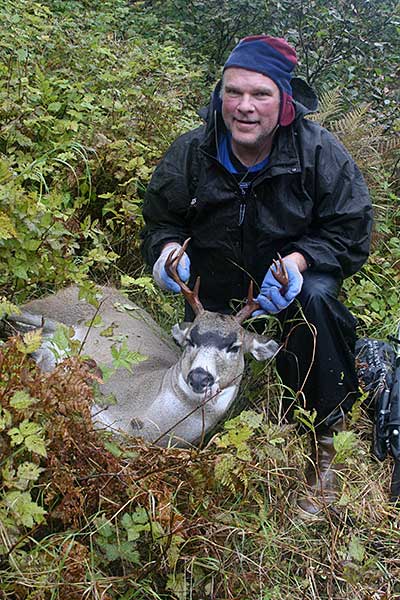
At about 100 pounds, give or take, blacktail deer are one of Alaska’s smallest big game hunted for food. Unlike moose, elk or bison, deer is a critter you can get out of the woods by yourself. Dragging is an option if you take one near the beach or camp. If you are further afield, then it usually takes about an hour to skin and butcher a deer and load it in your pack. How you get your deer out of the woods depends on how strong your back is, how much daylight is left, and the distance to transportation.
Deer season in most of Southeast Alaska is Aug. 1 to Dec. 31. In the islands I hunt near Juneau, only bucks can be taken Aug. 1 to Sept.14, after which either sex is legal. The bucks in August and early September tend to be in the alpine, and I’m not much of an alpine hunter. I’m still busy putting up salmon and berries for the year during that time. The huckleberry bushes and devil’s club still have their leaves then, too. I usually start deer hunting in October, when the leaves start to fall. Visibility is often less than 50 yards with the leaves off. With the leaves on, it’s down to 10 or 20 yards. Once the leaves turn color, all it takes is one good storm to blow most of them off and visibility improves a lot.
I like deer hunting because you always get a lot of exercise hunting, whether you get a deer or not. My summer is spent fishing, which I only do from a skiff here. When September rolls around, I usually find myself a little (or a lot) out of shape after a summer on the boat, so I start walking to and from work to get into some semblance of shape. In our part of Southeast Alaska, you either drive or boat to where you plan to deer hunt. Then start walking. And climbing. Deer hunting here is not, for the most part, something that you can do if you can’t hike several miles. No one I know hunts out of a stand for deer here. The deer browse on feed then seem to bed where ever they happen to be. They don’t travel to and from feeding and bedding areas as white-tail deer do. Weather and food seem to dictate where they are at any time. Plus, in terms of deer density, we have nowhere near the numbers of deer per square mile as say, where I grew up in western New York, where the whitetail deer take in Allegany County alone can exceed the entire statewide blacktail deer harvest here. Could be it’s just our tradition to hunt on foot and a tree stand could work. In any event, that’s how we do it.
The annual harvest limit is four deer in most of the region. I also proxy hunt for an elder troller in Petersburg and an elder fishery biologist in Kodiak. And now, my 13 year old nephew is old enough to hunt with me and get meat for my sister’s family. A hunter can get meat 100 pounds at a time and spread hunting out over the fall and early winter, processing each deer as you go. Deer hunting becomes a way of life rather than a short term “hunting trip”. It makes me never want to leave Southeast Alaska - rain, wind, politicians, and all.
Deer can be taken on the beaches, especially in years of big snowfalls. During those times, it may be a matter of beaching the boat, stepping off, and shooting. But having hunted deer in several parts of Southeast Alaska, Juneau area deer seem exceptionally wary of boats. They’ll stand on the beach as you cruise by, but any change in the boat speed or direction seems to send them running for the woods. I’ve only taken deer on the beach near Juneau on one occasion, and that was because we were able to maintain the boat speed until we got around a point out of sight of the deer, and then stalk back to the deer using the point as cover. I have taken deer on the beach in other less-hunted areas of Southeast Alaska, where the deer seem much less wary.
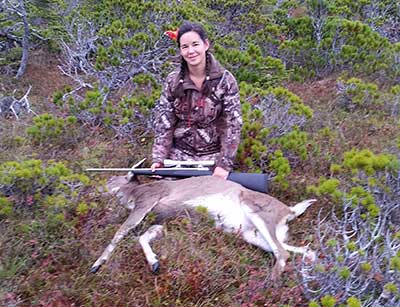
So back to real deer hunting. On foot. In the woods. I do mine by running my skiff to the area I’m going to hunt, anchoring the boat offshore enough to keep it floating through the low tide, and then it’s into the woods and up the hill you go. There are few flat areas to hunt anywhere in Southeast. By mid-October, the deer usually have moved from the summer alpine areas down to lower elevations, following their food sources. The summer biting bugs are also gone.
I rely on a deer bleat call for most of my hunting. The call can imitate a mewing doe or a bawling fawn. I have rarely seen a deer while walking through the woods that hadn’t seen me first. Since I don’t carry a shell in the chamber for safety, by the time I chamber a shell and get the scope covers off, the deer has bounded away. Even when you can see relatively far in the rainforest, you can walk right by a deer. That’s where the call comes in. A call brings the deer to me, where I hopefully pick up the sound, but more often the movement, of the deer as it comes in. Even in the thick brush, a deer can be almost silent coming in.
I generally hike until I find an area where I can see 50 yards in the woods, or find a muskeg, which are open semi-boggy areas where large trees don’t grow. If I’m hunting with a partner, I place them in a shooting lane where I think a deer may come in when I call, and I make sure we know where each other are for safety sake. Then I find a comfortable spot to stand or sit, chamber a shell, take off the scope covers, and sort of let things be quiet for a spell before calling.
Several calls are available for sale, but I make my own. A call is basically a two piece case with a reed sandwiched between. Kind of like a harmonica but without the different notes. I’ve made calls using both wood and deer antler for the case. The center of each side of the case is hollowed out to make an opening for air to pass the reed and make the sound. I usually use a bench grinder, but a knife works in a pinch if I have to make a call in the woods from a piece of stick. Once the space hollowed out, the two case pieces are pulled apart, and a reed is pulled tight across one of the pieces, then the other piece placed back on top and the ends of the call taped together to hold the case together. I’ve seen reeds made from rubber bands and surveyors tape. My favorite is the cloth-type (not the plastic-type) electrical tape, which gives me the pitch I favor. Both the material used for the case and the reed will determine the pitch and volume of the call. My wood case call has a little lower pitch than the antler call, but the antler call is much louder. Both work. The call works by bringing a doe to check on a bawling fawn. Or a buck to check on a doe checking on a fawn. Or a buck that is responding to a mewing doe. Or so the experts say. I just know they work.
I make 4 long bleats on the call. Then I count to 300, and call again. Then count to 200 and call again. Then count to 100 and call again. In my younger years, I’d make 3 series of calls without counting in between and then move on to the next spot. I’d think I’d been calling for half an hour, when really it was only 10 minutes. As I’ve gotten older, I’ve become more patient and find that patience pays off. I’ll usually make at least 6 series of calls before I move, and usually more than that. If there’s a doe around, she’ll usually come to the call on the first or second series. Sometimes with a buck in tow, especially during the fall. After that, it seems like lone bucks come in later – after the 6th series of calls or later. And many times they don’t come directly to the call unless it’s during the rut, but will tend to skirt their way in cautiously to see what’s going on. I’m sure in my younger years I left many a buck that showed up where I had been calling because I was too impatient and had moved on to another location. There are still days I come home without a deer, but now I get some nice bucks on days I’d not have seen anything in my younger days. And the bucks generally are larger and put more meat in the freezer.
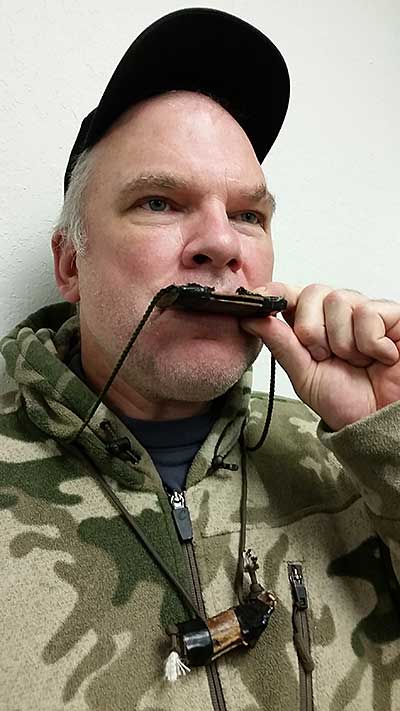
The firearm I use depends on where I will be hunting. When hunting in brown bear country – on Admiralty, Chichagof or Baranof Island - I use a .30-06 in case I run into a brown bear. Luckily, I have had no run-ins with brown bears there. The few times I’ve seen a bear, they’ve run away. Other hunters I know seem to run into bears every time they deer hunt. Maybe I’m noisy or give off a particular scent or am just lucky. I’m guessing many more bears have seen or smelled me than I’ve seen them and just let me walk by. I’ve never had an inkling to hunt brown bears because I would not be eating them. My motto is: you leave me alone and I’ll leave you alone. It’s worked thus far. In addition, I’ve never called in a bear to a deer call (that I know of, anyway). I often use a 30-30 or .243 caliber when I hunt areas like Prince of Wales Island and Douglas Island, where there are black bears but not brown bears. These lighter loads do less damage to deer meat, have little recoil, and most importantly, are lighter weapons to carry all day.
Although some frown on neck shot placement, many times that’s the best spot you have when you see a deer and it is my favored shot placement. Most shots are taken at 50 yards or less, and many times the neck or head shot is what you have. In addition, it damages the least meat. When calling in a deer, they generally stop and stare at you for enough time to get a good rest and an accurate shot. One of the biggest mistakes I’ve made is rushing a shot at a deer coming to the call at some distance when in hindsight, the deer was not in a hurry nor seemed to know I was there. In most cases, the deer will come in much closer for an easy shot if I remain calm and still. Those are things only experience teaches you.
Another reason for neck shots is deer fall where they stand. It’s difficult to tracking a deer in rainforest country, unless there’s snow on the ground. If you do see hair, you know you hit it, but tracking is another matter. Forest trails and muskegs don’t leave much for prints. The interior of the rainforest is dark, and the colors of fall muskeg plants contain many red shades of color (as you can see in some of the photos) – in both cases, it’s difficult to see blood. A hunt this mid-October is a good example. My hunting partner Kurt shot a doe that was coming to the call in a big muskeg. The deer saw Kurt at about 75 yards out. I was next to Kurt only 10 yards away and could not see it. Kurt got a rest against a tree and wanted the deer to come closer as he drew down on it, but when he saw it start to walk away, he fired. We were hunting Admiralty Island and both had 30-06 rifles. After he shot, he could not tell if the deer was hit or where it ran after recovering from the recoil. I thought I heard a stick crack. We went to the spot the deer had been standing, and could not find any hair or blood. We both walked in the direction the deer was heading when Kurt shot, and could find no tracks or blood. I went back into the brush about 10 yards and backtracked to where the deer had been standing. And there it was. Under some small spruce trees that made the area it was lying in almost dark. When we dressed and butchered the deer, we found Kurt had hit right through the heart. It was dead before we walked up there and we would not have heard any thrashing. This was another lesson to us to always make an effort to look for a deer that’s been shot at, since it could be down and very close by, even though there’s no sign or sound it was hit.
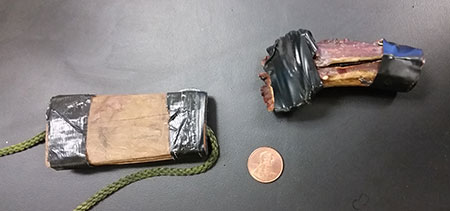
Dressing a deer for dragging usually takes 10 minutes or less with practice. If I’m going to drag the deer, I keep the cut in the body cavity at a minimum to reduce the amount of dirt or forest litter that can get in there. When I get to where I can hang the deer, then I open the cavity up a little more and put a stick across the opening to cool the body cavity if I’m not going to get the hide off of it right away. If I’m with a hunting partner and we get a deer early in the day and plan to drag it to the beach, we’ll hang it high enough in a tree so a bear can’t reach it, mark the area with flagging tape so we can easily find the deer, then continue hunting and retrieve it on the way down. If I drag the deer to the beach, I sluice out the carcass in the saltwater before loading it on the boat. It does wonders to clean out the inside. I usually take the hide off a deer soon after getting it home or to camp. It lets the meat cool faster, and if it’s below freezing, it prevents you from having to try to remove a frozen-on hide.
If I’m far from the beach or vehicle, then I butcher the deer in the field. I usually hang the deer from a tree here in Southeast Alaska, but have butchered deer on the ground with my sister in law on Afognak Island where there were no trees handy. For game bags, I carry pillow cases bags I’ve sewn from bed sheets. They are stout, allow good airflow, and reusable. After pulling the hide from the deer, I begin butchering by removing both front quarters, then the back straps, then tenderloins, then the neck meat, then the rib meat, then both hind quarters. The backbone, rib bones, neck bone and head are left in the field. A saw is not needed unless you choose to take the rib bones with the rib meat.
The meat will fit into the one of the sheet game bags or two pillow case bags, and these are tied to my frame pack for the hike down. Having a stout frame pack with comfortable shoulder straps is as essential for deer hunting as it is for the larger game animals. I like a pack that has some sort of appendage high up on the pack frame that I can put my gun sling over, as well, to free my hands for climbing while carrying my rifle. Some hunters use internal frame packs, which I’ve tried but were not as comfortable to carry with a load of deer meat as the frame pack.
Standard deer hunting gear in Southeast Alaska are layers of polyester, fleece or similar materials for tops and bottoms that will dry quickly and not retain moisture. Cotton is not a good option here as it’s going to get wet from sweat if next to the body, or from the rain if it’s an outer garment, and it will stay wet and make you cold. It takes a long time to dry as well. I wear rain pants when hunting if the temperature is above freezing because even if it’s not raining, in most cases the brush you wade through will be wet from previous rain or morning dew. That’s another thing I’ve learned with age – you have to put your raingear on before you get wet, and not after, if you want to remain comfortable and warm all day. For boots, I’ve yet to find anything better than Xtra Tuffs, whether the older models that were made in the USA or the newer ones made in China. The combination of the boots having an ankle fit, being water proof, and having a non-slip tread that is good on a boat deck seem to be the keys to popularity of them in Southeast. Fleece booties over socks work well to keep the boot on tight and your feet warm and dry.
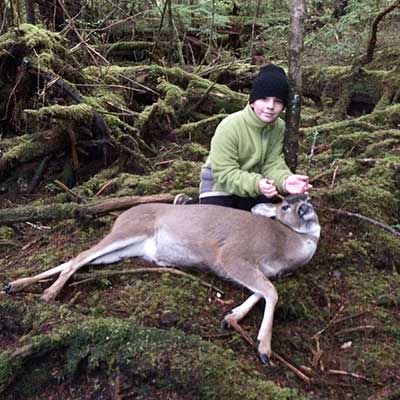
To my palate, all of Alaska’s deer are good to eat, but black tail deer is the mildest tasting, with bison a close second. We usually package cuts of meat for meals that include a roast or steaks from the front quarters, some large roasts from the hind quarters, and the back straps and tenderloins for frying or grilling. The rest of the deer (shanks, smaller pieces of meat trimmed from the quarters, rib meat, and the heart) we freeze together from each deer. After the season is over, we pull all of these bags of meat trimmings out, thaw them just enough to be able to cut the meat into chunks, and grind it into hamburger. We don’t add anything to the hamburger and like it just that way. It seems sacrilege to add fat from a cow on some distant farm to perfectly good Tongass venison, but some people like it.
Some people hunt for trophies. I hunt for meat. I’m not saying I won’t take a big-antlered buck if it comes along. I just don’t pass up legal adult deer waiting for a big buck to come along. Fall is our time for deer hunting and high bush cranberry harvesting. The venison and cranberries go into the freezer alongside the hooter grouse, fiddleheads, stinging nettles and devils club buds harvested in the spring, and the salmonberries, blueberries, huckleberries, salmon, rockfish and halibut harvested in the summer. Winter is for marten trapping, clam digging and cutting next year’s firewood. I don’t measure the harvest by money spent or money saved. It’s the act of gathering the food and consuming it that keep us healthy – excess baggage and all. It’s why we live here.
Mark Stopha is a Juneau-based fishery biologist and an an avid hunter and outdoorsman. He wrote about grouse hunting in the spring of 2015.
More on deer
Deer research: Calling and capturing deer
How are the deer? Surveys offer insights
Subscribe to be notified about new issues
Receive a monthly notice about new issues and articles.
